
Image from: Tadzhikskai͡a Sovetskai͡a Sot︠s︡ialisticheskai͡a Respublika / glav. redaktor M.S. Asimov
published by: Glavnai︠a︡ nauchnai︠a︡ redakt͡sii͡a Tadzhikskoĭ Sovetskoĭ Ėnt͡siklopedii
U of I Library Call Number: International & Area Studies Central Asian Reference (Slavic) 915.86t1224
OCLC Accession Number: 08460205
The Republic of Tajikistan’s neighbors (Afghanistan, Uzbekistan, Kyrgyzstan, and China), as well as its role as part of the Russian Empire and later the Soviet Union have all contributed to the political situation of this nation which celebrates its independence from the Soviet Union on the anniversary of 9 September 1991, and its new constitution was adopted on 6 November 1994. However, soon after gaining its independence, Tajikistan became embroiled in a civil war that lasted for much of the 1990’s, until the current President was elected in 1999. Today the Republic of Tajikistan is involved with many international organizations including the United Nations (after gaining entrance into the UN in 1992), as well as the International Monetary Fund (IMF). Since much of the country’s development as an independent state has taken place after the advent of the Internet, it is possible to find many of the government’s current publications online in downloadable formats. There is also a plethora of government-produced material available from Soviet times and earlier; dating from the 19th century when the area was under Khanate rule.
For a broader overview of Tajik publishing, the Tajik National Bibliography research guide has vast amounts of information regarding all aspects of Tajik publishing history to present day.

Print Bibliographies
Katalog Arkhiva Kokandskikh Khanov XIX veka.
A.L. Troit͡skai͡a. Moskva : Izd-vo “Nauka,” Glav. red. vostochnoĭ lit-ry, 1968.
U of I Library Call Number: International & Area Studies Central Asian Reference (Slavic) 016.9587 T74k
OCLC Accession Number: 04845239
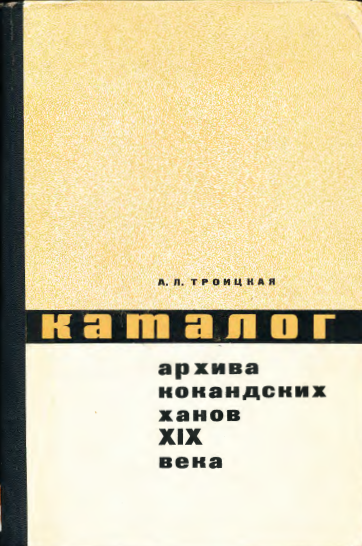 The researcher N.N. Pantusov described part of the archive of the Kokand Khanate in an article, “Arkhiv kokandskogo khana” in Turkestanskie vedemosti (1876, no.12), stating that it was comprised of approximately one thousand documents containing important information on statistics, the inner workings of the madrasas and mosques, the structure of taxation and revenue sources, and military matters (such as lists of types of weapons, accounts of expenditures for forging of weapons, lists of deserters, etc.). There were also notations of expenditures for soldiers’ pay and lists of gifts received by the khan.
The researcher N.N. Pantusov described part of the archive of the Kokand Khanate in an article, “Arkhiv kokandskogo khana” in Turkestanskie vedemosti (1876, no.12), stating that it was comprised of approximately one thousand documents containing important information on statistics, the inner workings of the madrasas and mosques, the structure of taxation and revenue sources, and military matters (such as lists of types of weapons, accounts of expenditures for forging of weapons, lists of deserters, etc.). There were also notations of expenditures for soldiers’ pay and lists of gifts received by the khan.
The archive of the Kokand khans is a typical “managerial” archive; most of the documents are related to the reign of Khudāĭār Khan (covering the years 1866-1875). A smaller number of the documents relate to the Shīr ‘Alī Khan (1842-1845), the father of Khudāĭār Khan and Malla Khan (1858-1862). The events of the time period covered by the archive are reflected in the materials preserved in the archive and included in this catalog.
It contains material on land ownership, its use and taxation; rules for being exempt from taxation; documents regarding regulation of materials used for heating (burning, cooking), as well as household items, clothing, and items relating to horses. There are surprisingly few materials on the tariffs that were levied on the various bazaars and for the sale of livestock. The archive also includes well-developed sections on military matters such as recruitment of soldiers, equipment and pay, and production of weapons. Other aspects of the economy are also represented, such as oil mining and production of kerosene, and the production of bricks and matches. Many of the documents that have been preserved refer to the household of Sultān Murād-Bek, and as a result it is possible to trace in minute detail the expenses for the bek’s palace, its upkeep, the cost of servants, etc., however there are virtually no accounts of the bek’s lands and private income, since these were beyond governmental control. There is also evidence of folk traditions which may be of special interest to ethnographers. Finally, the archive offers a rare glimpse into Central Asian diplomacy, a subject that is still not well developed in scholarly literature.
Although the archive has relatively narrow chronological and geographical delimitations, it is invaluable as a historical document. The research of the archive’s materials sheds light not only on the inner workings of the khanates of Central Asia, but also in part the workings of other countries of the Middle and Near East. What follows is a brief listing of types of materials that can be found within the archive. Here is a listing of the kinds of materials found in the catalog; in the book’s introduction they are described in more detail.
- ‘Ināĭatnāma – literally “letters of permit.”
- Mubāraknāma – Literally “letter of blessing.”
- Patta – Today’s meaning would be “check,” “voucher.”
- Patta-ī rasīd – Receipts for receiving monies. These type of documents are described in the archive using the old Russian term otpis’. In the archive we find two kinds of these documents:
- Those issued by the khan’s or bek’s servants confirming receipt of money from tax collectors
- Those issued on the spot to the taxpayers for having paid the tariff
- Daftar – Lists are the notes of the tax collectors marking the issuing of food items (especially meat) in the palace households.
- Dzham’ daftar – Itemized lists which were compiled documenting the incoming of taxation money, debit, and credit.
- Nāmgūĭ – Lists. (Archive only contains two nāmgūĭ)
- ‘arīẓa – This term means “all address.” (both oral and written addresses, by someone higher on the societal ladder to a lower-ranked person)
- Letters – these usually concern household and farming matters.
- Reports and orders. (Concerning management of land and taxes)
The documents of the archive are described using the Russian nomenclature. This is followed by the local name of the type of material. In many cases, names of documents in the vernacular are lacking and are given approximately, based on similar items present in the fond. In the glossary, the documents which have names in the original language are marked by an asterisk. Other information given in the description are contents, extent of document (for materials pinned or grouped together), the size, and the date (which is given in brackets if it is established by indirect means).
In the listing of items, the description of the document, the name of the recipient is put first, while the name of the sender is listed second. When personal names and local terms are listed, the transliteration used incorporates three Cyrillic vowels (a, u, y), with the appropriate corresponding diacritics. When mentioning names, honorifics and professional titles such as Mullah, Khodzha, Khadzhi, etc. are used and listed alphabetically, due to the fact that in Central Asia honorific titles are often an integral part of a person’s name.
The language of the archival documents is Tajik, so language is not mentioned in the description unless it is Uzbek, which is the language of only a few items. The script also is not indicated, since all the documents are written in the Middle Asian Nasta’līḳom. In the description of the documents, some terms were approximated and translated into Russian, while others were given in the vernacular without translation. In the latter cases the terms had multiple meanings, some of which changed throughout time, and some had such specifically local meaning that a succinct translation into Russian would be virtually impossible.
The catalog is constructed systematically with detailed rubrics. At the end of each rubric, after the indicator “sm. takzhe” we find numbers of other documents from other chapters, which are relevant to the same topic. Within each rubric the material is divided in alphabetical order, by the Russian name of the documents, names of addressees and names of senders. In the section documenting the decision on judicial matters regarding financial and real estate disputes, the material is listed according to the Russian names of documents, in the order of the names of the owners, or by the names of the parties involved in the court matter. In the chapter “Tax relief for the military”, which consists of a large number of dated documents, the material is listed in chronological order. On page 495 of the Katalog, the index section starts; there is a proper name index and a geographic and topographic name index, a glossary of terminology used, and a table of contents.
Kitobḣoi Jumḣurii Tojikiston: feḣrasti bibliografī (1991-2010).
Karimzoda, Mirzobadal., Ikromī, Sirojiddin. Dushanbe: “Khonai kitob,” 2011. 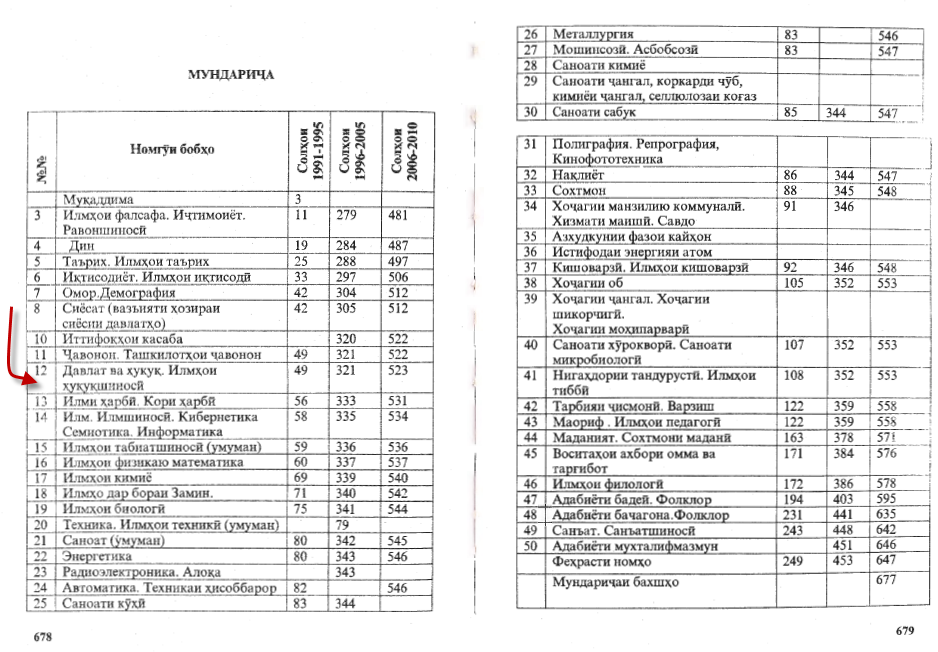
U of I Library Call Number: International & Area Studies Central Asian Reference (Slavic) 016.9586 K649
OCLC Accession Number: 761288720.
Published in 2011, this bibliography of books in the Republic of Tojikiston is an impressive compilation of Tojikī, Russian, and Uzbek titles published during 1991-2010 period, which makes it, in the absence of a functioning online catalog, one of the most important sources for materials published in Tojikiston for the stated period. This bibliography is organized into three sections with approximately 49 subject headings each, and three separate author indexes, one at the end of every section: 1991-1995, author index,pp. 249-276; 1996-2005, author index, pp. 453-478; 2006-2010, author index, pp. 647-676. Regardless of language or subject matter, each section is numerically organized and subdivided according to the subject order found in the table of contents.
There are approximately 4949 titles listed in this bibliography: 1991-1995[1740 entries]; 1996-2005[1602 entries]; 2006-2010[1607 entries]. The subject headings are in Tojikī (top heading) and Russian. The item entry numbers start with “1” at the beginning of each section. Most of the entries contain bibliographic data on the number of copies printed, language, institutional and geographic identifiers. The subjects found in this bibliography, and the page numbers for the start of each section are displayed on the image to the right.
The image seen below shows examples of the beginning of each section on government and law publications (click on the image to see a larger PDF version of the entries).

Statistical Publications
Statisticheskie publikatsii v SSSR: bibliograficheskii ukazatel. / E. A. Mashikhin, V.M. Simchera.
 Published: Moskva: Statistika, 1975.
Published: Moskva: Statistika, 1975.
U of I Library Call Number: International & Area Studies Central Asian Reference (Slavic) 016.3147 M37s
OCLC Accession Number: 3686263
In the Soviet Union, most of the statistical publications were the exclusive domain of government organizations, working under the aegis of Tsentral’noe Statisticheskoe Upravlenie (TsSU) in all its permutations. With the passage of time, the control of the TsSU over statistical research and output grew, and the role of other governmental bodies in producing statistical materials diminished.
This guide lists both all-Soviet and local publications of the ЦСУ СССР and ЦУНХУ Госплана СССР for the years 1931-1941. It also includes the production of statistical branches of the ЦСУ of the particular Soviet republics, as well as statistical publications produced by smaller, local institutions and governmental organizations The scope of the entire guide is the statistical publication of the Soviet Union for the years 1918-1972.
The first part of the guide focuses on the historical outline of the development of the publications, while their bibliographical corpus is arranged by subject in part two. The second part includes official statistics publications, issued by statistical entities at all levels: the highest central (All-Soviet) as well as those of Soviet republics, through all the administrative division units of oblast’, krai, and below (mestnye). Materials published in the languages of the various nations of the USSR are listed in Russian translation. Each of the entries consists of the following elements: Author name, title and subtitle, publication data (date and place of publication, publisher), pagination, and where applicable the information provided at head of title.
The first part of the work gives a historical outline of the development of statistical publications in the Soviet Union, including names of statistics-producing entities, and names of publications through the years. A brief analysis of the titles’ publication history is also described in the body of the text, with citations and notes in the footnotes.
The second part is divided as follows:
- statistical publications of the central governmental organs of the Soviet Union, including general statistical sborniki and spravochniki, as well as the works of the Tsentral’noe statisticheskoe upravelenie.
- statistical publications of the governmental organs at the level of Soviet republics, as well as the levels of oblast’, krai, and city.
- serial statistical publications published by the central government as well as the governments of the republics
- materials from conferences, congresses, and planned publications

The top, right-hand image is an example scan of the start of the Tajik section of statistical publications of Soviet Republic of Tajikistan, which continues on the next page. Below is another example entry from section 4A (p.86), of part 2

As a basis for the work, the authors used the existing bibliographic works on Soviet statistics, as well as various histories of Soviet statistics. Among the most notable ones are:
Ezhov, A.I. Organizatsiia statistiki v SSSR. Moskva Statistika, 1968.
Massal’skii, V.I. Gosudarstvennaia statistika poslerevoliutsionnogo perioda in. Fortunatov, A.F. O statistike, M: TsSU, 1921.
Periodicals consulted in the writing of the work included: Vestnik statistiki, Planovoe khoziaistvo, Problemy ekonomiki, Voprosy ekonomiki, as well as regional statistical journals. In preparing the guide, the authors used the collections and catalogs of the Institut nauchnoi informatsii AN SSSR, Fundamental’naia biblioteka AN SSSR, Gosudarstvennaia biblioteka SSSR im. V.I. Lenina, Nauchnaia biblioteka im. A.M. Gorkogo, libraries of TsSU SSSR, Gosplan SSSR, as well as the Book Chamber, the Statistikal cabinet im A.I. Chuprova (Leningrad), and various economic institutes.
Agentii Omori Nazdi Prezidenti Jumḣurii Tojikiston = Agentstvo po Statistike pri Prezidente Respubliki Tadzhikistan = Agency on Statistics Under President of the Republic of Tajikistan
(Website unavailable as of Jan. 2020 – Try CIA World Fact Book for Statistics and Reference)
The national Statistical Agency is the center for Tajikistan’s statistical activities. The Agency is administratively autonomous, and is responsible for population censuses, household surveys, demographic statistics, and various other economic statistics involving national and international trade, government finance, agricultural labor and social statistics – for which the Agency compiles the data from administrative records, and the National Bank of Tajikistan compiles monetary data.
The figures produced by the Statistical Agency are governed by the Law on State Statistics (No.588, dated January 12, 2010), that establishes the independence of the Statistical Agency and guarantees the confidentiality of the data provided by the individual statistical units. Links to the full text of current publications produced by the Agency appear in all three languages (Tajik, Russian, and English) of the Website; in many cases the publication will have the two or three languages within the text, but in the case of single-language publications the language of the text will match the language of the version of the Website which is being viewed (i.e., English language website will provide the English-language version of the publication and the Russian language website will provide the Russian-language version). However, there is no indication as to the language or languages of the publication in the linked text, and some titles are not available in all three languages. The language of the Website can be changed via the links on the top left-hand corner of the website.
 The main publication of the Statistical Agency is the monthly report Socio-Economic Situation that includes the latest monthly data with brief commentary, and is circulated among top government officials. The report is published by the 12th day of the month following the accounting period. Other annual publications are issued as listed below:
The main publication of the Statistical Agency is the monthly report Socio-Economic Situation that includes the latest monthly data with brief commentary, and is circulated among top government officials. The report is published by the 12th day of the month following the accounting period. Other annual publications are issued as listed below:
- Omori solonai Jumḣurii Tojikiston = Statisticheskiĭ ezhegodnik RT = Statistical Yearbook of Tajikistan
- Agentii Omori nazdi Prezidenti Jumḣurii Tojikiston. Dushanbe: Kumitai davlatii omori Jumḣurii Tojikiston, 2001- present
Location: International and Area Studies Library, Central Asian Reference.
U of I Library Call Number: 314.86 Om62
OCLC Accession Number: 52180800
- Agentii Omori nazdi Prezidenti Jumḣurii Tojikiston. Dushanbe: Kumitai davlatii omori Jumḣurii Tojikiston, 2001- present
- Mintaqaḣoi Jumḣurii Tojikiston = Regiony RT = Regions of Tajikistan
- Agentii davlatii omori nazdi Ḣukumati jumḣurii Tojikiston. Dushanbe: Gosudarstvennoe statisticheskoe agentstvo pri pravitelʹstve Respubliki Tadzhikistan.
(Published in Russian starting in the year 2000; Tajik language publication began in 2005)
OCLC Accession Number: 61163647 (No holdings at UIUC)
- Agentii davlatii omori nazdi Ḣukumati jumḣurii Tojikiston. Dushanbe: Gosudarstvennoe statisticheskoe agentstvo pri pravitelʹstve Respubliki Tadzhikistan.
- Tojikiston dar raqamḣo va i͡ak qator digar nashrii͡aḣo = Tadzhikistan v t͡sifrakh = Tajikistan in Figures
- Agentii davlatii omori nazdi Ḣukumati jumḣurii Tojikiston. Dushanbe: Gosudarstvennoe statisticheskoe agentstvo pri pravitelʹstve Respubliki Tadzhikistan, 2000- present
U of I Library Call Number: International & Area Studies Central Asian Reference and Main Stacks 315.86 T12
OCLC Accession Number: 54389767
- Agentii davlatii omori nazdi Ḣukumati jumḣurii Tojikiston. Dushanbe: Gosudarstvennoe statisticheskoe agentstvo pri pravitelʹstve Respubliki Tadzhikistan, 2000- present
Under the heading Publication (Nashrii͡aḣo / Publikat͡sii), the user will find the Catalog (Feḣrast / Katalog) of publications, which lists all titles produced by the Agency, the date of the latest survey, frequency of publication, and the language or languages in which each title is published (the image below shows the first few titles listed in the catalog). The Survey results (Natijaḣoi tadqiqotī / Rezul’taty obsledovaniĭ) give the user access to downloadable files of surveys such as agricultural surveys; infant, child, and mother mortality rates; migration surveys, and survey results for the construction and trade sectors. The Electronic versions of publications (Versii͡aḣoi ėlektronii nashrii͡aḣo / Ėlektronnye versii publikat͡siĭ) section provides, as the name suggests, the linked PDFs to the full text of publications ranging from 2005 through 2011. They include more numerous publications from previous years than may be found from the menu on the Home (Asosī / Glavnai͡a) page, and may be viewed as what serves as the Agency Website’s publications archive. Overall, however the publications from more recent years are much more numerous than those available from earlier years. Some of the more recent publications, such as those from 2010 or 2011 may not always be linked, and the user may be directed to another page with more current publications and press releases; some of the available PDFs are of differing statistical works as well as surveys.
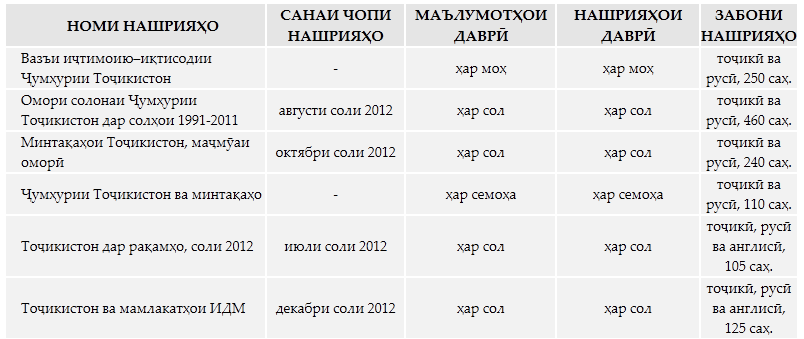
The Database (Khazinai ma”lumotḣo / Baza dannykh) page offers a multitude of downloadable Microsoft Excel documents of different survey topics, categorized by dating in some cases back to 1991. As in other publications, many of these tables are available in the three languages of the Website. (This page was unavailable in January of 2020, try the World Heritage Organization for similar information. Generally the Russian language databases are more complete, and all sectors have statistical or survey results available for downloading; the English version has slightly fewer, with the Fiscal sector offering 1 item; Financial sector offering 3 items, External sector has no items available. As of September 23, 2012, the Tajik language version of Bakhshi ḣaqiqī and Bakhshi ijtimoii͡u demografī are the only two categories with figures available.
The Links page (Istinodḣoi mufid / Poleznye ssylki) provides a listing of links to various Tajik State Department Websites, including the National Bank of Tajikistan, the Ministry of Education, the Ministry of Foreign Affairs (which has some publications available online in the Russian version under Periodicheskie izdanii͡a i publikat͡sii), among others. Also listed are websites for Donors and Partners, including but not limited to the Official Website of the United Nations in Tajikistan, the Statistics Agency of Kazakhstan, and the Official website of the Federal State Statistics Service of the Russian Federation.
![]()
Online Government Resources
Ḣamoḣangozii Kūmaki Beruna – Kumitai Davlatii Sarmoiaguzorĭ va Idorai Amvoli Davlatii Jumkhurii Tojikiston = Koordinatsiia Vneshneĭ Pomoshchi – Gosudarstvennyĭ Komitet po Investitsiiam I Upravleniiu Gosudarstvennym Imushchestvom Respubliki Tadzhikistan = Foreign Aid Coordination – State Committee on Investments and State Property Management of the Republic of Tajikistan
The State Committee on Investment and State Property Management (SCI) of the Republic of Tajikistan was approved on November 30, 2006, by the Decree of the President of the Republic of Tajikistan «On improving the structure of central executive bodies of the Republic of Tajikistan» № 9. The SCI was mandated to implement several functions, including those of:
- the former State Committee on State Property Management and the Aid Coordination Unit under the Executive Administration of the President
- the Aid Coordination Unit under the Executive Administration of the President
- the former Ministry of Finance of the Republic of Tajikistan (issues related to attraction of investments)
- the former Agency for Antimonopoly and Support for Entrepreneurship under the Government of the Republic of Tajikistan
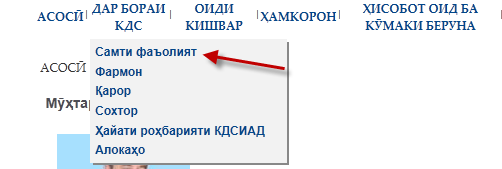
Further information about the SCI can be found by clicking the Samti Fa”olii͡at/Profil’/Profile option under the “Dar Borai KDC/O GKI/About SCI” tab, along with links to various Decrees affecting the role of the SCI.
The website focuses on the activities of the State Committee on Investments, whose primary function is to manage deals with agencies interested in foreign investment Tajikistan, and support activities that would promote an attractive investment climate. The website includes the full text of Decrees and speeches given by the president and other government officials, provides information on the government and Committee structure, as well as provides freely available linked files of published documents. Information available on the site allows the user to learn about Tajikistan’s external aid inflow data. The website includes information relevant to a broad audience, “including public bodies, international organizations, local executive bodies, non-governmental organizations, civil society representatives and beneficiaries themselves.”
The current committee PDF documents (which may be from the years 2010 or 2011) are on the main page, and can be viewed online as well as downloaded. Those documents include:
- Ma”lumotnomai ḣarsolai ittilootii «Ḣamkoroni oid ba rushd» = Ezhegodnyĭ informat͡sionnyĭ spravochnik «Partnery po razvitii͡u » = Annual Information Directory “Development Partner Profiles”
- Ḣisoboti solona dar borai kūmaki beruna = Godovoĭ otchet o vneshneĭ pomoshchi = Annual “Foreign Aid Report”
- Makhzani ma”lumoti sistemai ḣamoḣangsozii kūmaki beruna va monitoringi loiḣaḣo = Baza dannykh Sistemy koordinat͡sii vneshneĭ pomoshchi i monitoringa proektov = Database of Aid Coordination and Project Monitoring System (ACPMS)
- Kharitai kūmaki berunai Tojikiston = Karta vneshneĭ pomoshchi Tadzhikistana = Tajikistan Foreign Aid Map
All of the documents and webpages on this website are available in all three languages (Russian, Tajik, and English). However, in order to find any document in another language, the language of the entire website must be changed; when the language of the site is changed, the user is always automatically taken back to the home page, so navigation to the desired page or document must start again. The language selection options are located in the top right-hand corner of each page, just under the banner and search box.
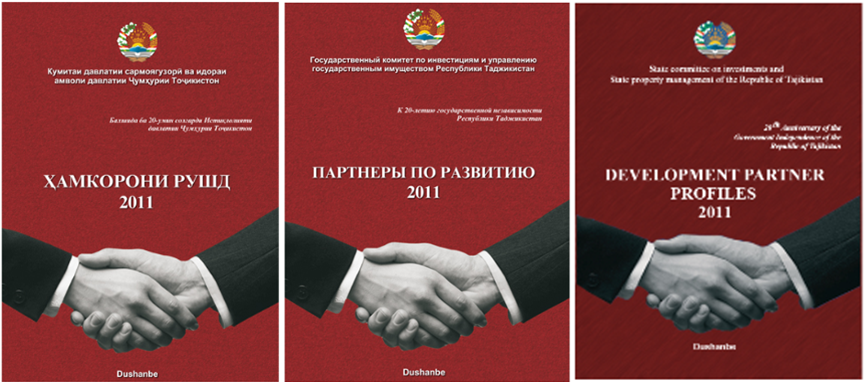
On the left-side menu, which remains the same on each page of the website, are links to different pages, having to do with various aspects of the SCISPM and a listing of some of their published documents:
The Strategic Documents section includes documents created throughout the 2000-2009 decade, in order to increase the living standards of the Tajik population. With the production of these documents, the President and the Tajik Government initiated the development of several long- and medium-term national development strategies to address economic challenges met by the Republic, and to promote financial stabilization. In 2007 those strategic documents were adopted by the government, and can now be accessed on the website menu under Strategic Documents; the fly-out menu provides access to Strategic Documents of the Government, Joint International Documents, and several documents regarding Assistance Strategies of International Organizations.
The Foreign Aid Report is broken up into segments that appear in the fly-out menu when mousing over the page link, including the database output tables from the report, along with a brief explanation of the tables under the tab called “Foreign Aid Reports.” The 2010 Report contains information on foreign aid as of December 31, 2010, and was published by the State Committee on Investments and State Property Management of the Republic of Tajikistan (SCI), with funding from a UN development program.
Government Regulations of the Republic of Tajikistan includes links to downloadable Word Documents of the laws and codes of Tajikistan dating as far back as the mid-1990’s. The documents available for viewing and downloading vary from one language to another, and more documents are available in Tajik, Russian language also includes a significant number of full text, and English has the least amount of documents available, but all three language options include some important materials for international investment.
Ministerstvo Finansov Respubliki Tadzhikistan
http://minfin.tj/
(Website unavailable as of Jan. 2020, try http://vdushanbe.ru/catalog/society/ministerstvo-finansov-respubliki-tadzhikistan/)
The site’s main text and documents are available in Russian as well as Tajiki. The Website includes a multitude of documents available for download regarding the works of the Ministry of Finance. Documents involving the different aspects of the Ministry’s work such as the development strategy of public internal financial control; legal practices of the Ministry; financial management and internal controls in the private sector; audits in the public sector; internal standards for audits, ethics and other financial practices; documents regarding the Tajik budget, including implementation and performance reports (these are also available in English); trends in economic development; documents on relations with foreign financial agencies, and more. Documents on the website are in fully searchable PDF or Word document format, and may date as far back as 2006.
The documents can be accessed by either clicking on the main tabs located at the top of the site, or by mousing over the tabs to the drop-down menu and selecting the desired topic. There is no specific page designated for “publications,” instead the relevant documents have been included on each Webpage of the site.
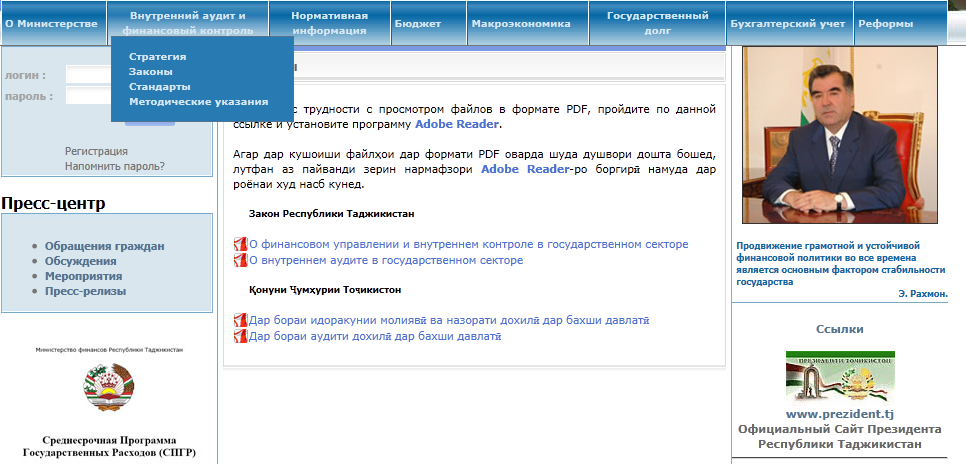
Along the right-hand side of the website, the user will find links to other relevant ministries’, committees’, and projects’ websites